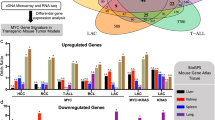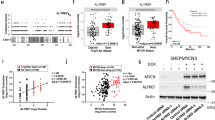Abstract
In addition to its role in invasion and metastasis of several tumors, the multifunctional urokinase receptor uPAR (urokinase plasminogen activator receptor) is directly involved in the growth of several cancer cells in vitro and in vivo. We have compared growth rate and oncogenic transformation in wild-type (wt) or uPAR−/− mouse embryonic fibroblasts (MEFs). Surprisingly, uPAR−/− MEFs grew faster than wt MEFs. This agreed with elevated levels of cell cycle mediators like extracellular signal-regulated protein kinase, p38, AP1 and Cyclin D1. Infection with a uPAR retrovirus reverted the effect, decreasing the growth rate.When MEFs were transformed with H-RasV12 and E1A oncogenes, the efficiency of transformation in uPAR−/− MEFs was higher than in wt. UPAR−/− MEFs grew faster at low serum, produced more colonies in agar and produced tumors in vivo in nude mice with a lower latency period. The properties of the heterozygous uPAR+/− MEFs were always intermediate. We conclude therefore that in MEFs uPAR concentration controls cell proliferation and the transforming activity of some oncogenes.
This is a preview of subscription content, access via your institution
Access options
Subscribe to this journal
Receive 50 print issues and online access
$259.00 per year
only $5.18 per issue
Buy this article
- Purchase on Springer Link
- Instant access to full article PDF
Prices may be subject to local taxes which are calculated during checkout




Similar content being viewed by others
References
Aguirre-Ghiso JA, Kovalski K, Ossowski L . (1999). Tumor dormancy induced by downregulation of urokinase receptor in human carcinoma involves integrin and MAPK signaling. J Cell Biol 147: 89–104.
Aguirre-Ghiso JA, Estrada Y, Liu D, Ossowski L . (2003). ERK(MAPK) activity as a determinant of tumor growth and dormancy; regulation by p38(SAPK). Cancer Res 63: 1684–1695.
Aguirre-Ghiso JA, Liu D, Mignatti A, Kovalski K, Ossowski L . (2001). Urokinase receptor and fibronectin regulate the ERK (MAPK) to p38 (MAPK) activity ratios that determine carcinoma cell proliferation or dormancy in vivo. Mol Biol Cell 12: 863–879.
Behrendt N, Ploug M, Patthy L, Houen G, Blasi F, Danø K . (1991). The ligand-binding domain of the cell surface receptor for urokinase-type plasminogen activator. J Biol Chem 266: 7842–7847.
Blasi F, Carmeliet P . (2002). uPAR: a versatile signalling orchestrator. Nat Rev Mol Cell Biol 3: 932–943.
Crowley CW, Cohen RL, Lucas BK, Liu G, Shuman MA, Levinson AD . (1993). Prevention of metastasis by inhibition of the urokinase receptor. Proc Natl Acad Sci USA 90: 5021–5025.
Dano K, Behrendt N, Hoyer-Hansen G, Johnsen M, Lund LR, Ploug M et al. (2005). Plasminogen activation and cancer. Thromb Haemost 93: 676–681.
Dewerchin M, Nuffelen AV, Wallays G, Bouche A, Moons L, Carmeliet P et al. (1996). Generation and characterization of urokinase receptor-deficient mice. J Clin Invest 97: 870–878.
Estreicher A, Wohlwend A, Belin D, Schleuning WD, Vassalli JD . (1989). Characterization of the cellular binding site for the urokinase-type plasminogen activator. J Biol Chem 264: 1180–1189.
Fazioli F, Resnati M, Sidenius N, Higashimoto Y, Appella E, Blasi F . (1997). The urokinase-sensitive region of the urokinase receptor is responsible for its potent chemotactic activity. EMBO J 16: 7279–7286.
Hahn WC, Weinberg RA . (2002). Modelling the molecular circuitry of cancer. Nat Rev Cancer 2: 331–341.
Høyer-Hansen G, Rønne E, Solberg H, Behrendt N, Ploug M, Lund LR et al. (1992). Urokinase plasminogen activator cleaves its cell surface receptor releasing the ligand-binding domain. J Biol Chem 267: 18224–18229.
Huai Q, Mazar AP, Kuo A, Parry GC, Shaw DE, Callahan J et al. (2006). Structure of human urokinase plasminogen activator in complex with its receptor. Science 311: 656–659.
Karin M, Liu Z, Zanardi E . (1997). AP-1 function and regulation. Curr Opin Cell Biol 9: 240–246.
Kiyan J, Kiyan R, Haller H, Dumler I . (2005). Urokinase induced signaling in vascular smooth muscle cells is mediated by PDGFR-beta. EMBO J 24: 1778–1797.
Kook YH, Adamski J, Zelent A, Ossowski L . (1994). The effect of antisense inhibition of urokinase receptor in human squamous cell carcinoma on malignancy. EMBO J 13: 3983–3991.
Lakka SS, Rajagopal R, Rajan MK, Mohan PM, Adachi Y, Olivero WC et al. (2001). Adenovirus-mediated antisense urokinase-type plasminogen activator receptor gene transfer reduces tumor cell invasion and metastasis in non-small cell lung cancer cell lines. Clin Cancer Res 7: 1087–1093.
Liu D, Aguirre-Ghiso J, Estrada Y, Ossowski L . (2002). EGFR is a transducer of the urokinase receptor initiated signal that is required for in vivo growth of a human carcinoma. Cancer Cell 1: 445–457.
Llinas P, Le Du MH, Gardsvoll H, Dano K, Ploug M, Gilquin B et al. (2005). Crystal structure of the human urokinase plasminogen activator receptor bound to an antagonist peptide. EMBO J 24: 1655–1663.
Lund AH, Turner G, Trubetskoy A, Verhoeven E, Wientjens E, Hulsman R et al. (2002). Genome-wide retroviral insertional tagging of genes involved in cancer in Cdkn2a-deficient mice. Nat Genet 32: 160–165.
Mazzieri R, Blasi F . (2005). The urokinase receptor and the regulation of cell proliferation. Thromb Haemost 93: 641–646.
Mazzieri R, D’Alessio S, Kangang-Kemhoe R, Ossowski L, Blasi F . (2006). An uncleavable uPAR mutant allows dissection of signaling pathways in uPA-dependent cell migration. Mol Biol Cell 17: 367–378.
Min HY, Doyle LV, Vitt CR, Zandonella CL, Stratton-Thomas JR, Shuman MA et al. (1996). Urokinase receptor antagonists inhibit angiogenesis and primary tumor growth in syngeneic mice. Cancer Res 56: 2428–2433.
Ossowski L, Aguirre-Ghiso JA . (2000). Urokinase receptor and integrin partnership: coordination of signaling for cell adhesion, migration and growth. Curr Opin Cell Biol 12: 613–620.
Ploug M, Ostergaard S, Gardsvoll H, Kovalski K, Holst-Hansen C, Holm A et al. (2001). Peptide-derived antagonists of the urokinase receptor affinity maturation by combinatorial chemistry, identification of functional epitopes, and inhibitory effect on cancer cell intravasation. Biochemistry 40: 12157–12168.
Ploug M . (2003). Structure–function relationships in the interaction between the urokinase-type plasminogen activator and its receptor. Curr Pharm Des 9: 1499–1528.
Reuning U, Magdolen V, Wilhelm O, Fisher K, Lutz V, Graeff H et al. (1998). Multifunctional potential of the plasminogen activator system in tumor invasion and metastasis. Int J Oncol 13: 893–906.
Selleri C, Montuori N, Ricci P, Visconte V, Carriero MV, Sidenius N et al. (2005). Involvement of the urokinase-type plasminogen activator receptor in hematopoietic stem cell mobilization. Blood 105: 2198–2205.
Serrano M, Lee H, Chin L, Cordon-Cardo C, Beach D, DePinho RA . (1996). Role of INK4a locus in tumor suppression and cell mortality. Cell 85: 27–37.
Sharpless NE, DePinho RA . (1999). The INK4A/ARF locus and its two gene products. Curr Opin Genet Dev 9: 22–30.
Shaulian E, Karin M . (2001). AP-1 in cell proliferation and survival. Oncogene 20: 2390–2400.
Shaulian E, Karin M . (2002). AP-1 as a regulator of cell life and death. Nat Cell Biol 4: E131–E136.
Stephens RW, Nielsen HJ, Christensen IJ, Thotlacius-Ussing O, Sorensen S, Dano K et al. (1999). Plasma urokinase receptor levels in patients with colorectal cancer: relationship to prognosis. J Natl Cancer Inst 91: 869–874.
Stephens RW, Pollanen J, Tapiovaara H, Leung KC, Sim PS, Salonen EM et al. (1989). Activation of pro-urokinase and plasminogen in human cells: a proteolytic system with surface-bound reactants. J Cell Biol 108: 1987–1995.
Stoppelli MP, Tacchetti C, Cubellis MV, Corti A, Hearing VJ, Cassani G et al. (1986). Autocrine saturation of pro-urokinase receptor in human A431 cells. Cell 45: 675–684.
Todaro GJ, Green H . (1963). Quantitative studies of the growth of mouse embryo cells in culture and their development into established lines. J Cell Biol 17: 299–313.
Wei Y, Eble JA, Wang Z, Kreidberg JA, Chapman HA . (2001). Urokinase receptor promotes β1 integrin function through interactions with integrin α3β1. Mol Biol Cell 12: 2975–2986.
Wilhelm O, Weidle U, Hohl S, Rettenberg P, Schmitt M, Graeff H . (1994). Recombinant soluble receptor as a scavenger for urokinase-type plasminogen activator (uPA). Inhibition of proliferation and invasion of human ovarian cancer cells. FEBS Lett 337: 131–134.
Acknowledgements
We are indebted to Davide Moi, Drs M van Lohuizen, Kristian Helin, Gunilla Hoyer-Hansen, Orla Cunningham and Cristina Moroni for useful discussions and the gift reagents. This work was supported by grants from AICR (Association for International Cancer Research, UK), AIRC (Italian Association for Cancer Research regional Grant), EU (IP Cancerdegradome EU CT 2003-503297; NoE MAIN, CT 2003-502935) and the Cariplo Foundation.
Author information
Authors and Affiliations
Corresponding author
Rights and permissions
About this article
Cite this article
Mazzieri, R., Furlan, F., D'Alessio, S. et al. A direct link between expression of urokinase plasminogen activator receptor, growth rate and oncogenic transformation in mouse embryonic fibroblasts. Oncogene 26, 725–732 (2007). https://doi.org/10.1038/sj.onc.1209833
Received:
Revised:
Accepted:
Published:
Issue Date:
DOI: https://doi.org/10.1038/sj.onc.1209833
Keywords
This article is cited by
-
D2A sequence of the urokinase receptor induces cell growth through αvβ3 integrin and EGFR
Cellular and Molecular Life Sciences (2018)
-
Urokinase receptor primes cells to proliferate in response to epidermal growth factor
Oncogene (2007)



